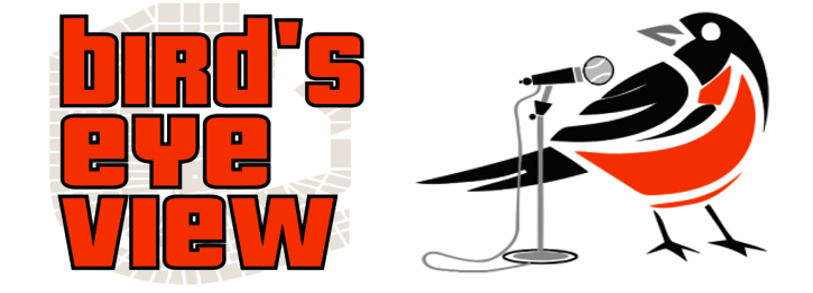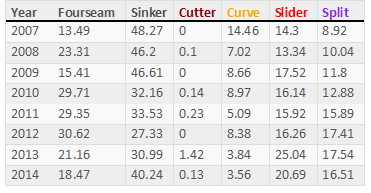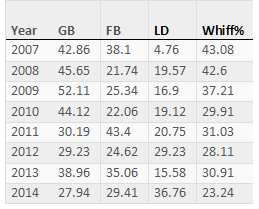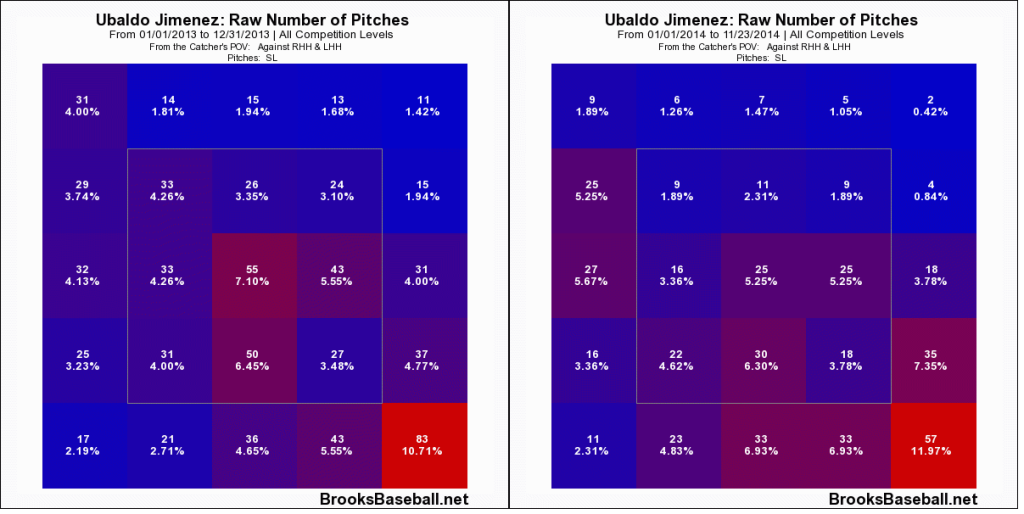The Orioles Should Keep Ubaldo Jimenez For 2015 And Beyond
Birdland, I implore you to please put down your pitchforks and torches at this time. Hear me out for even I am not sure I fully believe the statements that I am making at this time. However, that has never stopped me before from making ridiculous and outrageous claims for what the Orioles could, or rather, should be doing in the Front Office. Let us begin this journey into the insanity…
The Baltimore Orioles had a blossoming performance from their starters during 2014 with marked improvements as the season went on. The performances especially during the second half of the season left them as one of the best and improved starting rotation in all of MLB. This improvement can be seen starting in the month of July with starters posting impressive metrics for both traditional and sabermetric stats.
Many folks will be quick to point out that it was during this time that Ubaldo Jimenez was placed onto the disabled List on July 12th and only started in four more games for the rest of 2014 displaying once again poor performances. Most Orioles fans are ready to write off Jimenez as a bust. However, the performance of Jimenez in 2014 shouldn’t have been a major surprise. Jimenez has had sporadic performances since 2010, primarily due to the massive reduction in velocity in fastball velocity
Jimenez reduction in velocity has forced him to rely on more breaking ball pitches since 2010. These breaking balls have often been the slider followed by occasionally dabbling with a curveball. However, we can note in 2014 that that is sudden increased in a return to his hard-stuff specifically his sinker during 2014 (30.99% in 2013 compared to 40.24% in 2014).
Jimenez has not had major success with his sinker during his career. Analysis of the weighted pitch values per 100 pitches shows a below average result since his loss in velocity in 2010. However, it is interesting to note that for 2014, the slugging percentage has shown it be at the lowest (.389) since 2010 with his reduction in velocity.
Weighted Pitch Values/100
However, breaking out the data further for the Sinker shows a higher propensity of walks in 2014 with 47 of 77 (61.0%) walks occurring when using it. In addition, Jimenez has shown a propensity to use the sinker when behind on the batter for both LH and RH batter during 2014. However, these numbers compared to 2013 seem very similar in regards to the following pitch usage. The walk rate for the sinker was 41 of 80 (51.3%) indicating that Jimenez has a tendency to go to the pitch often when he is behind with three balls in the count. In fact, Jimenez relied on his sinker 58.91% during 2014 in three ball counts compared to 2013 with a 30.99% usage rate. In regards to zone positioning of the sinker, Jimenez has had a propensity for the sinker to being lower than the league average and in 2014 it was a historical worse at 38.98%.
It’s interesting to note that the four seam fastball was a fairly effective pitch for both 2013 and 2014 for him. Though the velocity is decreased, his usage of the pitch has limited batters to only a .204 BAA. However, it seems to have the same performance in terms of effectiveness as the Sinker. However, there does seem to be a higher chance of a whiff on the fastball when he is effective. Looking back at the second half of 2013, his whiff rate for his fastball was 11.34%. While this number was much lower during 2014, it did show back up at the end of the season with a value of 11.16% in August and September. Perhaps Jimenez should consider moving away from the sinker so heavily and balance it out with use of the fastball to induce strikes. Even if the ball is put in play, the LD% is low enough with the batting average backing it up to indicate that it could warrant moderate success when combined with the Sinker.
However, the biggest issue with Jimenez was not the usage of four-seam fastball versus the sinker. It was his effectiveness of his breaking ball pitches. They were so poor that it likely caused a higher usage and reliance on his sinker, which altered its efficacy since hitters expected it. Reviewing the weighted pitch values, the slider is the obvious change if efficiency moving from a weighted value of .97 (29th in MLB with minimum 100 IP) to -.67 (82nd in MLB with minimum 100 IP). Deviations for this slider efficiency can be seen in Average (.222 to .310), Slugging (.359 to .452), and lines drives per BIP (15.58 to 36.76). Analysis of the movement of this pitch compared from 2013 to 2014 shows that the horizontal movement is moving more (3.66” to 4.98”) and the vertical is diving more (2.59” to 2.16”). These do not appear to be a significant difference compared to the last year. However, if we look at Ubaldo’s numbers for rates for balls in play per pitch and whiff rate we see the following trend for the slider:
His success with the slider is directly proportional to the amount of line drives that is being put into play and continuing to get that high whiff%. When we spoke to Dan Weigel in Episode 93, he mentioned this was more likely due to muscle memory issue or a possible change in grip by coming into the Orioles organization. We also spoke about pitching backwards where a pitcher often times uses a breaking ball on first pitches. This is evident by his use of the Slider on first pitch to RH 29% of the time even though it only was in the zone 35% of the time. In order to improve by pitching backwards, Jimenez will have to figure out how to keep his slider in the zone for a strike as well as it dropped from 41% in-zone in 2013. By keeping it in the zone more often as well, it should induce a higher whiff percentage as well.
With an entire off-season and no longer being dangled on the free agent market, Jimenez may be able to get the slider worked out as he’s demonstrated his ability to be effective with it in the past. In addition, if he can balance his usage of his fastball and sinker especially on first pitch it may be of benefit to get ahead on batters.
If he can do that, then maybe he can become the dominating pitcher that he was in 2011 and 2013. If the Orioles get that player, he could easily turn into a more valuable starter than the $12.25 million owed to him. In addition, it would give the Orioles the freedom to trade away another starter this offseason? Whom might they trade away and what could they get? We’ll answer that in the future on Baltimore Sports Report.





